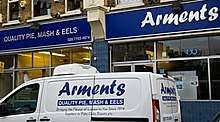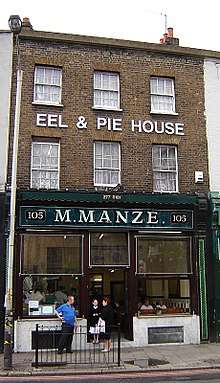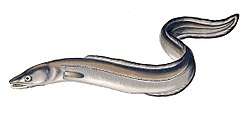Jellied eels
Jellied eels are a traditional English dish that originated in the 18th century, primarily in the East End of London. The dish consists of chopped eels boiled in a spiced stock that is allowed to cool and set, forming a jelly. It is eaten cold.
A plate of jellied eels | |
| Place of origin | English dish |
|---|---|
| Main ingredients | Eel, spiced stock |

History

The eel was a cheap, nutritious and readily available food source for the people of London; European eels were once so common in the Thames that nets were set as far upriver as London itself, and eels became a staple for London's poor. The earliest known eel, pie and mash houses opened in London in the 18th century, and the oldest surviving shop, M Manze, has been open since 1902.[1]
At the end of the Second World War there were around 100 eel, pie and mash houses in London;[2] in 1995 there were 87.[3] Now there are very few, although jellied eels are sold in some of the capital's delicatessen shops and supermarkets.
The water quality of the Thames has improved greatly since the 1960s and is now suitable for recolonisation by eels.[4] The Environment Agency supports a Thames fishery, allowing nets as far upriver as Tower Bridge.[5]
Preparation

The dish is traditionally prepared using the freshwater eels native to Britain. Typically, the eels are chopped (shucked) into rounds and boiled in water and vinegar, to make a fish stock, with nutmeg and lemon juice before being allowed to cool. The eel is a naturally gelatinous fish so the cooking process releases proteins, like collagen, into the liquid which solidify on cooling to form a jelly, though gelatin may be added in order to aid this process.
Recipes for jellied eels are individual to particular London pie and mash shops, and also street sellers; however, traditional recipes for authentic Victorian jellied eels all have common ingredients and cooking methods. What varies is the choice of herbs and spices used to flavour the dish.
Jellied eels are often sold with pie and mash, another traditional East End food, and eaten with chilli vinegar or with malt vinegar and white pepper.
Outside the UK
In Denmark the dish is known as ål i gele, in France as aspic d'anguille, in Germany as Aal in Aspik, and in Poland as węgorz w galarecie; all terms mean jellied eel. In Sweden the dish is named ålaladåb, after the French term à la daube.
In popular culture
- In the Dishonored series of games by Arkane Studios, "Pratchett's Jellied Eels" are a common food item. In the 2017 game Prey, also made by Arkane, jellied eels are a common food item, as a reference to Dishonored.
See also
References
- Donald Strachan (8 Aug 2012). Frommer's London 2013. John Wiley & Sons. p. 244.
- Copping, Jasper (2007-06-18). "Eels in danger of slipping off the menu". The Telegraph. Telegraph Media Group Ltd. Retrieved 2008-12-11.
- Richard Schweid (2010). Consider the Eel. Univ of North Carolina Press. p. 94.
- Naismith, I. A.; B. Knights (2005-04-04). "The distribution, density and growth of the European eel, Anguilla anguilla, in the freshwater catchment of the River Thames". Journal of Fish Biology. 42 (2): 217–226. doi:10.1111/j.1095-8649.1993.tb00323.x. Archived from the original on 2013-01-05. Retrieved 2008-12-11.
- "Commercial Fisheries in the Thames Estuary". ThamesWEB. ThamesWEB.com. Archived from the original on 2006-11-27. Retrieved 2008-12-11.
Further reading
- http://www.bbc.co.uk/dna/h2g2/A8573132 Background
- https://www.theguardian.com/netnotes/article/0,6729,680948,00.html Jellied eels story at The Guardian, 8 April 2002
- Would you Adam and Eve it? Jellied eels hit by over-fishing London Evening Standard, 3 January 2012.
External links
| Wikimedia Commons has media related to Jellied eels. |
- http://www.pie-and-mash.com Website dedicated to an appreciation of Pie, Mash and Eels.
- http://www.barneys-seafood.co.uk The website of Barneys Seafood with links to their eels and stories about Eastend food culture and social history.
- Jellied Eel is also the name of the quarterly magazine of London Food Link , the network for food businesses, writers and campaigners promoting healthy and sustainable food in London (UK on the website of Sustain: The alliance for better food and farming)

